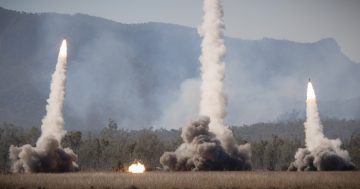
HMAS Brisbane fires an SM-2 missile from its Mk41 vertical launch system during a trial in 2020. Photo: LSIS Thomas Sawtell, ADF.
While the Australian Defence Force is building up its offensive strike capabilities, it is looking to dramatically bolster its air defence capabilities for many of the same reasons.
A major part of this effort is defence of Australia’s airspace through the development of a new integrated air and missile defence (IAMD) network under the ADF’s multi-phased Project AIR 6500.
IAMD is incredibly complex as it will be required to network civilian and defence sensors, data and voice communications, cyber defences and ‘effector’ missile systems from all three services across the Indo-Pacific region and present high-fidelity data in near real-time.
These sensors include civilian air traffic control (ATC) radars; the ADF’s Jindalee Over the Horizon Radar Network (JORN), which can see thousands of kilometres up beyond Australia’s northern approaches; Royal Australian Air Force TPS-77 radars operated by its two control and reporting units (CRUs); new air defence radars in development or planned for the Australian Army; and even the powerful new radars and combat systems aboard Royal Australian Navy ships at sea.
The development of artificial intelligence and machine learning should facilitate much of this integration as it will be infinitely faster than a human interface at collating data from multiple sources to be filtered and then fused into a common operating picture.
The first significant effort for the IAMD is the Project AIR 6500 Phase 1 joint air battle management system (JABMS) which will develop the architecture required to pull the IAMD system together. The requirements for JABMS are currently being developed by Defence in conjunction with two shortlisted strategic partners – Northrop Grumman Australia and Lockheed Martin Australia. Both companies have capabilities that apply to the JABMS requirement, including sensors, effectors, combat systems and vast levels of experience in integrating all of these systems.
The ADF’s current Project AIR 5333 Vigilare system entered service in 2010 and, for the first time, brought together sensor data from civilian ATC and defence radars. But it is not currently integrated with any air defence systems, so is more accurately described as a Network Centric Command and Control System (NC3S).
On top of that, the ADF’s only current land-based air defence system – the Army’s man-portable Saab RBS 70 – can only deal with threats out to 10 km, although Army has some grand plans in the works. In 2023 it is scheduled to take delivery of the first of its new short-range air defence systems under Project LAND 19 Phase 7B.

Concept art of the Army’s new Evolved NASAMS air defence system being developed by Raytheon Australia and Kongsberg Defence Australia. Photo: Raytheon Australia via ADF.
Based on the Norwegian Kongsberg NASAMS system, the Evolved NASAMS will feature advanced radars provided by Canberra-based CEA and be integrated with Army vehicles. Employing the same AMRAAM and AIM-9X missiles carried by Air Force fighter aircraft, the mobile E-NASAMS system will provide an air defence bubble out to about 25 km around bases or critical infrastructure.
Much of the production and integration for the E-NASAMS system is being performed by Raytheon Australia and Kongsberg and their Australian industry partners in Adelaide.
The ADF is also looking at a new medium-range air defence system and, in September 2021, released a request for proposals to industry for its Project AIR 6502 Phase 1 requirement. While this system’s required range isn’t publicly available, it is likely to be out well-beyond 50 km.

An evolved sea sparrow missile launched from HMAS Ballarat (FFH 155) as part of a live fire exercise during Exercise RIMPAC 2016. Photo: ADF.
The Royal Australian Navy already has very capable air defence systems, but it is expected these will have some level of integration into the future IAMD. All of its significant surface assets are equipped with Enhanced Sea Sparrow Missiles (ESSM) which can target enemy aircraft and cruise missiles out to a range of about 50 km when paired with advanced radar arrays and combat systems such as those on the Navy’s Hobart class destroyers and upgraded ANZAC class frigates.
In addition, the Hobart class carries the SM-2ER missile, which has a range of more than 100 km.
My Public Sector
In August 2021, the US State Department approved the sale of the more advanced SM-2 Block III and SM-6 which will add new advanced seekers, larger boosters and greater manoeuvrability for use against hypersonic cruise missiles and ballistic missiles out beyond 150 km. These are being procured under Project SEA 1300 Phase 1.
“The purchase of (SM-6) and (SM-2 IIIC) missiles is currently included in Australia’s procurement roadmap and will improve their ability to operate alongside U.S. and Allied naval forces against the full spectrum of naval threats,” according to the US Defense Security Cooperation Agency notification.





















